Family : Turdidae

Text © Dr. Gianfranco Colombo

English translation by Mario Beltramini
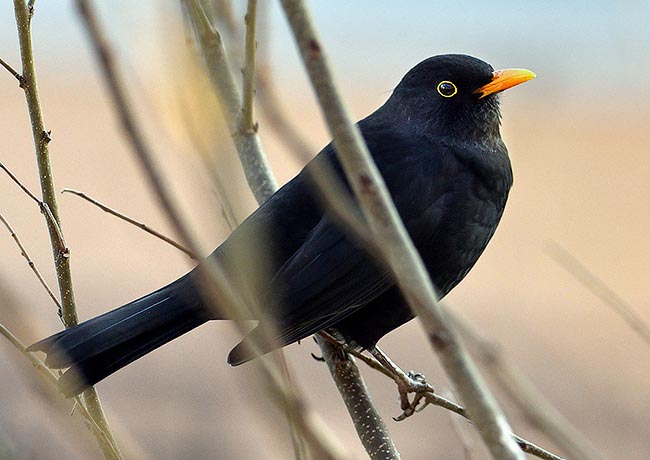
A male blackbird, boldy and territorial limits with its song, from sunrise to sunset, the invisible borders of its reign. Common in Europe, part of Asia and Australia where it has been introduced recently by man © Gianfranco Colombo
An old tale recites that once upon a time the blackbird was white but having shltered in a chemney for warming up, got out from there three days after completely black because of the soot.
They were the days 29, 30 and 31st of January, those that will be later on in the popular tradition, the “hen blackbird days”.
As we all know and have had way to easily see firsthand, the blackbirds are nowadays really black but, as we shall see later on, not really all.
The Common blackbird (Turdus merula Linnaeus, 1758) belongs to the order of the Passeriformes and to the family of the Turdidae and is now a very common bird between our houses even if only a few decades ago it was a bird purely of the country, woods and bramble bushes.
A habit that has led it, only in our western world, to live in close contact with the human being and take advantage of everything he does.
So today we see it pecking crumbs and leftovers, dodging cars and pedestrians and fighting with the ubiquitous city pigeons, then we hear it arguing and gaggling with our dogs and domestic cats, who are also disoriented by an unnatural detention, we find it nidifying in the thick of the wisteria, climbing on the neighbour’s balcony and producing more and more healthy and vigorous broods, we hear it in the morning warbling at full voice from the top of some TV antenna and waking us up out of hours that, though melodiously, does not forcefully coincide with the time decided for getting out of bed.
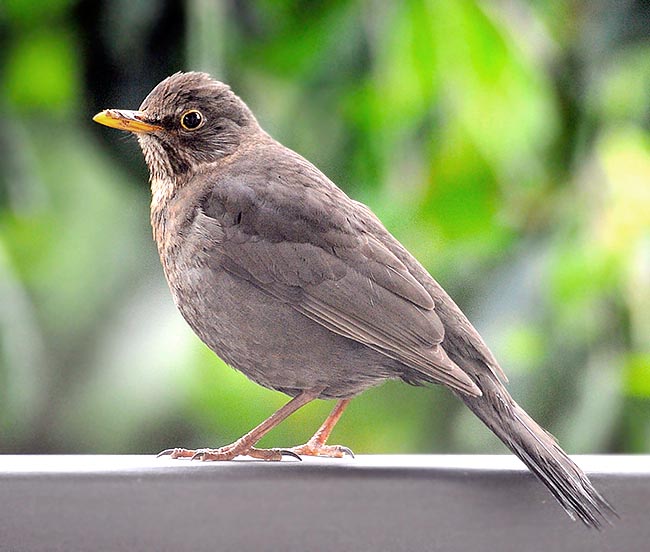
Female on a railing. It is one of the most anthropic birds that nowadays abandon countryside for towns © Colombo
This is the city blackbird, always in the way, amusing friend of all and sympathetic morning nuisance.
Actually, the biological clock of the blackbird, in particular by the beginning and the end of the day, is not too normal.
An hour before dawn it starts belting, without interruption, inventing all kinds of warble and trying to overwhelm the noise of the first morning traffic that flows careless under the roost.
During the reproductive period, it does it all the mornings from the same roost, whatever the weather, declaring all its antagonists of having taken possession of the territory.
In the evening, in pitch dark and before retiring inside its night shelter, here it is warbling with a crazy screech with that penetrant squik squik, to advise that for him the day is over.
The message is clear to all, for the consimilars, for the humans and for all surrounding nature: the boss is me.
In the sites that once where its natural habitats, woods and countries, Turdus merula has become a not much common bird as was in the past. It seems that the human conurbation of the second half of the last century, has dragged simultaneously with it this bird and its future.
There is then a remarkable difference between the city and the country blackbords. The first ones, besides taking advantage of the benefits coming from the human presence and his activities, give sign of a widespread general wellbeing, with continuous increase of the populations, with a constant widening of the places to colonize and an always more increasing shamelessness.
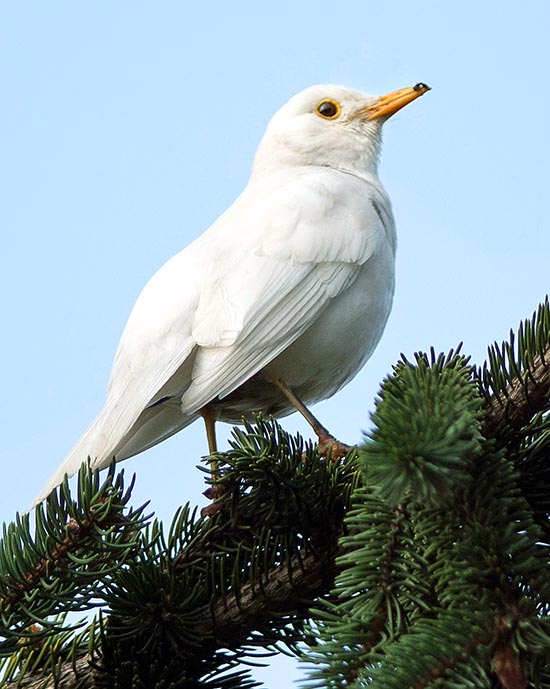
A rare white male of Turdus merula called leucist. It is not albinism, in this case eyes are not red but perfectly regular. It is a hereditary recessive genetic mutation © Gianfranco Colombo
Conversely, the country ones have the usual difficulties, lazy and suspicious of everything and everyone, always alert against possible predators, not a moment’s respite on all what surrounds them, un unthinkable escape distance towards the humans if compared to the city ones and unluckily a continuous decrease of their number.
As we said, Turdus merula is black but is occasionally affected by albinism and leucism with specimens, in particular males, more or less marked by spots, greyings or, more rarely, completely white.
Such a particularity does not go unnoticed even to the most inattentive observer. It is so much familiar that usually we do not even throw a look when it crosses the garden path, quick as a black rat, we do not deign it of a glance when it clucks alarmed on the railing of our balcony and not even when scratching in the leftovers fallen when shaking the tablecloth after lunch but much attentive when it shows special or unusual behaviors and ready to ask ourselves … but, is it our blackbird? But, what happened to him?
It’s one having entered by force our families.
The popular European tradition contemplates several tales and fables referred to Turdus merula.
Besides the traditional story of the white bird become blck owing to the soot, there are other popular tales recalling this bird.
In the X century Spain, the emir Abd-ar-Rahman I, builder of the Medina of Cordoba, owes to a white blackbird who sang on its windowsill, the conquest of his beloved wife Zagara and its recovery from the sadness that had perturbed him.
The countess Matilda of Canossa saw her blackbird getting ill and losing the feathers but saved it by immersing it in the waters of the sources of Casciana, Pisa that cured and rejuvenated it immediately. She repeated the test on herself and such were the benefits that she had built in loco in the XII century the first thermal plant.
They say that St. Syrus of Struppa, to whom was honoured a small church in the outskirts of Genoa, has made miracolous recoveries among which that of a blackbird to whom when young he was very fond.
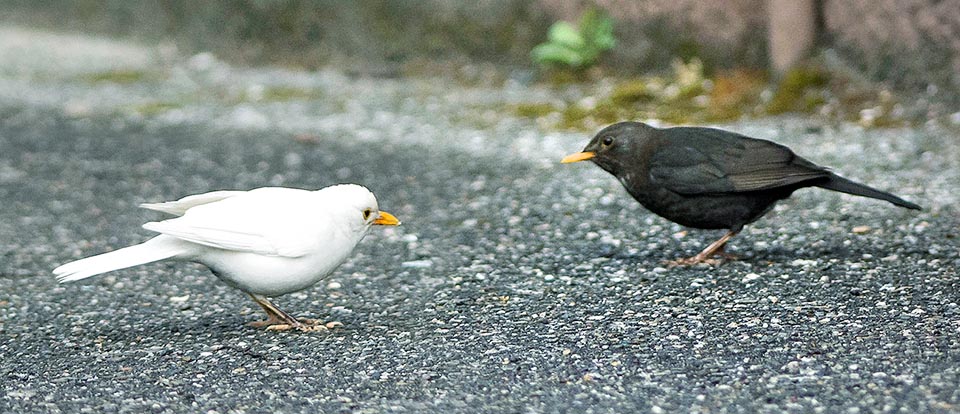
Usually two males so closed will slaughter themselves for territorial infraction but black mistakes it for another species and white may be does not realize to be a blackbird © Gianfranco Colombo
Due to the ease of how it is taken when hunting, in Italy it has been compared to a good natured and simpleton person, so much to enter our manner of speaking with the saying “you are dumb as a blackbird”.
However, this bird has the characteristics of cleverness and opportunism by sure not comparable to the archetype indicated by us, and the attitude taken as reference is characteristic of a certain period of the year when as the same hunters say, the blackbird eats a lot of grapes and perhaps gets drunk. On the other hand remains in the folk tradition also the saying referred to a congener that rightly has this vice “drunk as a thrush”.
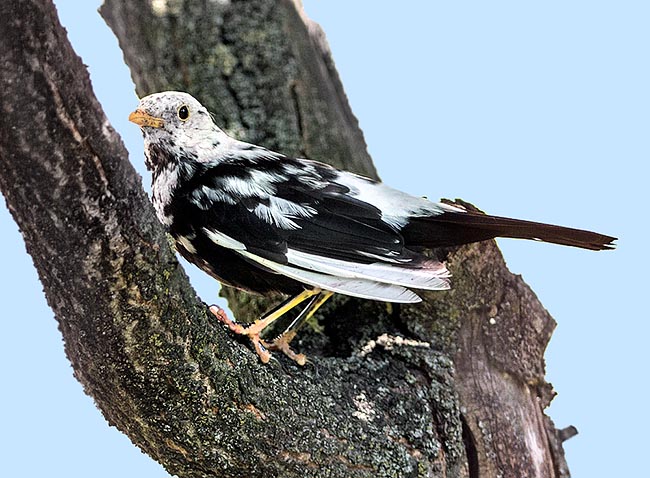
Leucism hits mainly males and even intermediate forms white stained are found © Gianfranco Colombo
Also cooking has taken in good consideration this tasty small bird. In Corsica is famous the paté de merle, in the province of Bergamo among the sacrificial victims of the “polenta e osei” (= polenta and birds) is never missing the blackbird, as well as in the skewers of Brescia.
And then who, living in the countryside, when child has not had one of them in cage?
Being a bird fairly precocious in the nidification, it was a target coveted by all the country boys to find during the first runs outdoors the first nest of blackbird, keeping it secret to friends and caring it till the birth of the chicks and taking then from the nest only one nestling, the most beautiful, the most sympathetic and of course, male, to breed it by hand.
It was the summer companion of many boys by sure not facilitated as today to travel to popular tourist destinations or misled by modern commitments, the pastime of the school holidays and in the mean time a daily obligation that was keeping us constantly occupied in the caring and in the attending our new friend. Often we took it in the wire cage also in open country to allow it to hear the free ones singing, seen that the mastery in the turdids is acquired by learning from other old singers. A continuous challenge with the other friends about who had the most beautiful blackbird.
Then in autumn, all the years and inevitably always in correspondence with the first days of school, mom informed us that while coming back from the lessons our blackbird had accidentally escaped while she was feeding it.
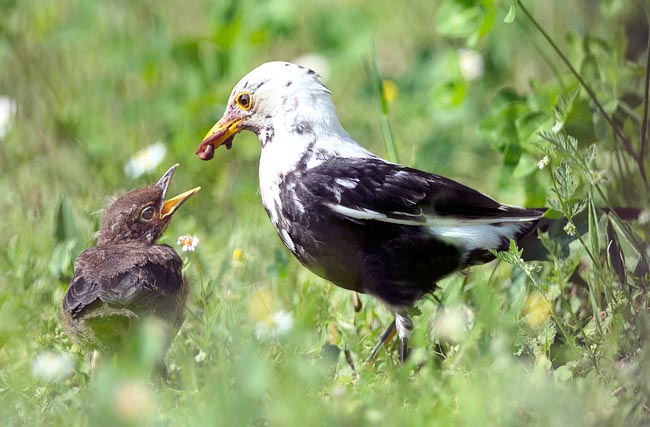
This fact does not prevent to couple and to take care of descendants as this keen father © Gianfranco Colombo
A good excuse of the parents for not distracting us from the study but immediately replaced by the intention to make up for by the next season.
In short, a bird who had entered our life in all senses, our archetype of the relationship between man and nature, the precursor of what will then be the pets of the future.
The etymology of its scientific name is rather simple: from the Latin “turdus”, that indicates a thrush and “merula” = Turdus merula
In Europe is called blackbird in English; Amsel in German; merle in French; mirlo comun in Spanish; merlo preto in Portuguese and merlo in Italian.
Zoogeography
The blacbird is a much diffused bird in Europe and in good part of Asia and Australia, carried and diffused by the European hemigrants or colonizers. In Europe is diffused everywhere up to the Urals but the coldest mountain areas of the Scandinavian Peninsula. In Asia, it lives in Asia Minor and Middle East, in part of Iran, Pakistan and India and in a vast area of China. In Africa, it is present only along the Mediterranean coasts of Morocco, Algeria and Tunisia.
Excepting Europe and some cities of the world, it is a shy and wild bird with behaviors well different from those shown in the western world.
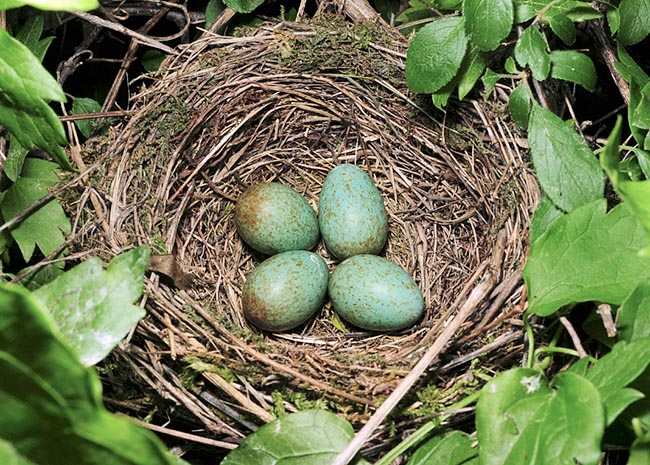
Usual nest is built on a dried up mud base mixed with smaller and smaller sticks, thin roots, musk and various linings. It may content even five bluish eggs spotted with red blotches © Gianfranco Colombo
Here the blackbird has remained old fashioned, like those living in our woods and in open country.
Turdus merula is usually sedentary and only the populations living in altitude or too much north go down in the bad season to the plains below and to some degree of latitude to the south.
The migration takes place during the first week of October whilst the return is done during the last week of February.
This movement is usually combined with that of the Song thrush (Turdus philomelos).
Turdus merula lives in even dense woods, in cultivated areas with brambles and bushes, in hilly and mountain zones up to 3.000 m, in locations with intensive cultivation with meadows surrounded by rows of trees, in city parks, in the cemeteries and as said also in the center of the busiest cities.
Morpho-physiology
The male of the blackbird has a completely glossy and bright black livery, with beak and ocular ring orange yellow and olive black legs. In winter the yellow colour diminishes greatly and the beak becomes greyish.
Also the female is black but duller, at times also ambre and with diffused brown colouration on the chest. The beak is blackish.
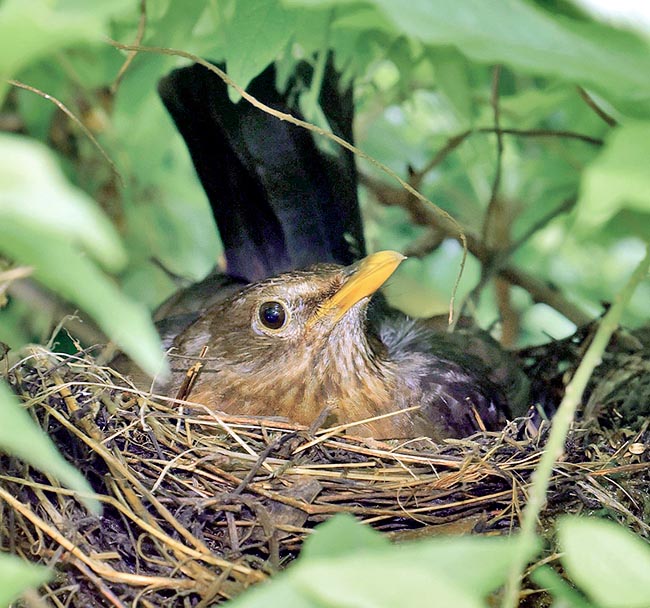
Brooding is mainly assigned to female and lasts in 15 days © Gianfranco Colombo
In autumn Turdus merula assumes at times a dusting of ash colour with superficial whitish moiré, in particular in the specimens subject to the just hinted short migration.
Conversely, the young are very clear in the livery with a brownish predominance diffused on the whole body and a yellow buccal margining they will lose after a few months.
Along all birds, Turdus merula is probably the bird most subject to chromatic variations in the livery, with forms more or less marked of albinism and leucism.
Usually it’s the male who are affected , in particular in the alar cover remiges but at times the white covers vast areas of the livery and also the legs, to specimens, these ones rather rare, completely white.
Also in the case of leucism of one of the partners, a genetic and hereditary anomaly, the young of the brood are almost never direct carriers of the gene but the particularity may reappear instead in future generations.
Turdus merula is one of the most talkative birds and renders itself noted in every season and in every situation. The territorial song, emitted in the months of nidification, is a mix of fluted trills accompanied by many more improvisations if compared to that of the musical phrases of the Song thrush (Turdus philomelos) and, after some connoisseurs, even more beautiful than that of the nightingale (Luscinia megarhynchos).
It has then a subdued and clucking song, a ciok ciok, like an undertone kiss it emits in any moment of the day to signal its presence, a sound that becomes very accelerated and more acute when emitted to signal some danger and that ends up in a very loud shrill outbreak with ensuing flight of the subject.
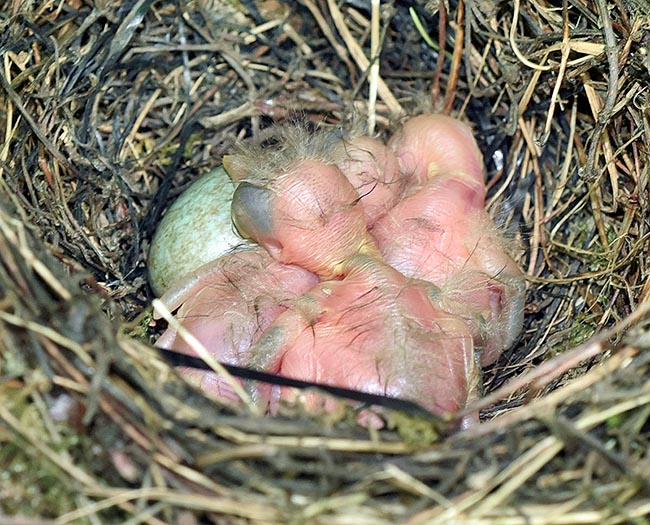
Just born chicks are practically bare © Gianfranco Colombo
In this phase it assumes a position with arched body, with tail and head raised and the wings totally lowered quivering nervously at each blast.
There is finally a sound emitted when the bird is menaced by serious dangers or by some intruder who gets too close to the nest.
A soft sound, a tsiii tsiii almost inaudible, ultrasonic, very fine, a warning message directed to its similars.
Ecology Habitat
The main alimentation of Turdus merula in the summer period and during the nidification consists in soil insects, earthworms, larvae and small snails, a diet it highly integrates in summer with berries of any type, from juniper to rowan, from wild grapes to any sort of fruits.
Particular is its way of hunting the insects hopping and running in just mown lawns, bending the head to one side and listening to any least noise the underground insect may emit.
Once the exact position is identified, here it is, hammering the soil with the robust beak to extract the hapless worm.
In the inhabited centres we can affirm that the diet of the blackbird has drastically changed. There is no food that it does not greedily gulp down, thus learning to eat aliments that the country brothers probably do not have and will never get the chance to taste.
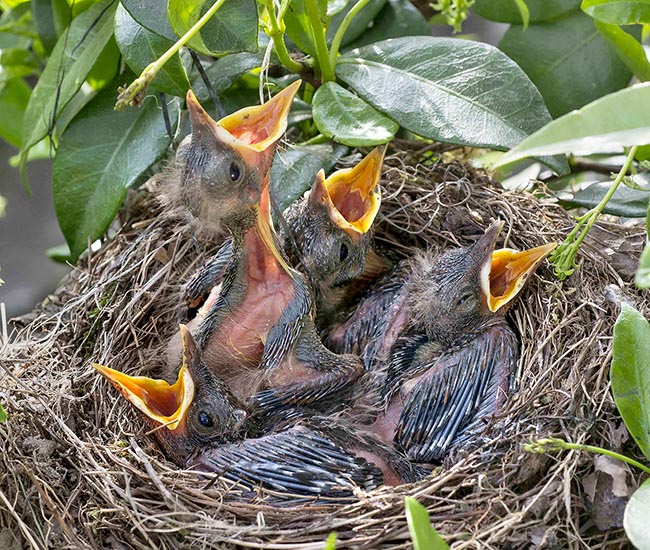
Feathers grows rapidly and chicks ask parents insistently for food © Gianfranco Colombo
Ethology-Reproductive Biology
Turdus merula loves to nidify on low bushes, on pollarded trees and also at the ground level on strains fallen on the soil or close to big roots. It is a very strong nest built on a base of dried mud mixed with smaller and smaller twigs, moss and various material to complete the inner cup with very fine rootlets.
The populations in contact with the human activities use now the most assorted materials. In the nests of metropolitan blackbirds have been found bits of string, pieces of plastic, of newspaper and rags of various colours. Pieces of cigarette packets, of cardboards, of electric wires, basically all what it finds around.
In the inhabited centres the nests are placed in unthinkable sites outside of all logic and criteria. Even inside semi-abandoned dwellings, in basements, in garages, in flower pots on the balcony, on the window sills an in any available green tuft.
In urbanized areas the nest can be used more times in the same season whilst n the country it is usually done again at each occurrence. The reproduction season is extremely long, as can begin in Ferbuary and end in August with three and occasionally even four broods. It lays three to five light blue eggs more or densely dotted by small reddish spots. The hatching lasts 15 days and is done almost exclusively by the female whilst the progeny is cared by both parents.
The young males are precocious and leave the nest as soon as able to scamper therefore after a few days and still unable to fly, they scatter in the surroundings. In this period the death toll is very high and good part of the brood dies for predation, accidents or sudden bad weather.
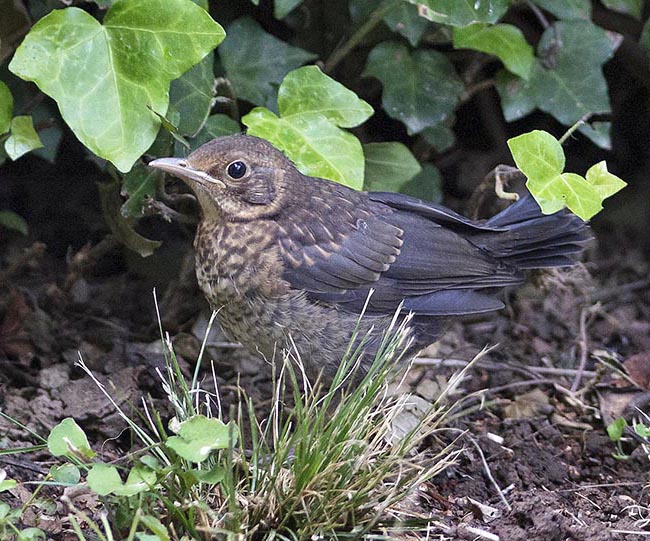
Youngs are very precocious and leave the nest as soon as able to trot. They scatter much earlier to learn to fly and are easy prey for cats and birds of prey, not to mention mortality tied to bad weather © Gianfranco Colombo
Seen the habit of the blackbird to use again the same nest for successive nidifications, we can think that the precocious exit of the young from the nest may come from the exigency of the mother to begin at once the new brood.
Turdus merula is very territorial and defends hardly its area, contrasting any intruder with violent struggles and pursuits. Also with its own kids, as soon as they have gotten the autonomy, is somewhat cruel and may even get to kill them if they are found in its jurisdiction when it has begun a new nest.
It defines its territory with well traced borders that it does not trespass and not even grants the consimilars to trespass them. It may be a flowerbed, a sidewalk, a small wall, limits for us indecipherable but for him absolutely clear and well defined.
Often are seen the two neighbouring males, facing each other for several minutes one metre away in wary and aggressive posture but without having any physical contact.
Although if for us there are no visible limits, that place is for them the impassable limit of its own territory. The blackbird is always watchful and careful and does not miss anything even when busy in caring the progeny.
Whilst terrible with its consimilars, it normally tolerates other small birds that live in its same area, from the Robin (Erithacus rubecola), ai to the House sparrow (Passer domesticus) and to the tits (Parus sp.) that are often seen roaming side by side while looking for food.
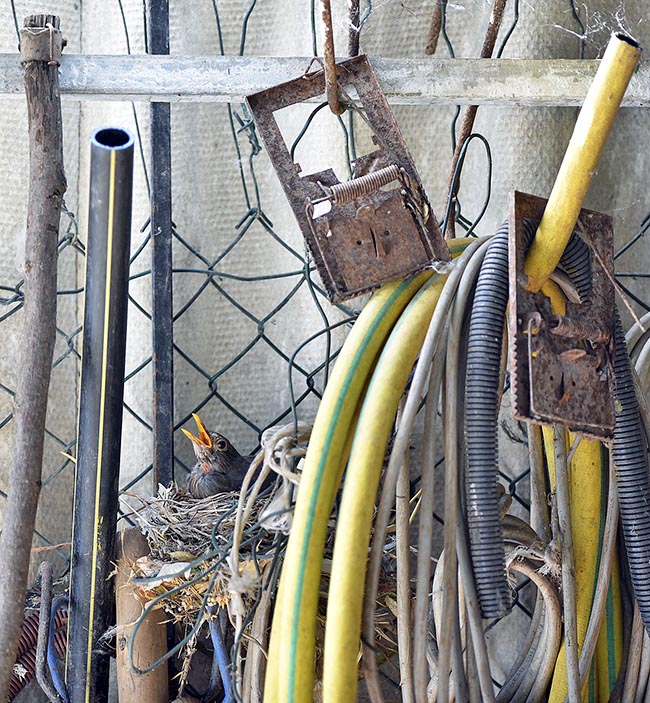
A nest hidden among tools shed. History of this bird a time wild, is always more tied to human being © G. Colombo
Oddly enough, while between two male blackbirds there is an extremely acute contrast in the territoriality, for which it is unimaginable to see two consimilars living peacefully closely, this does not happen when one of them has a different colouration.
In a feeding point it has been seen the presence of a white male blackbird and a black one that, in total peace, were eating a few cm far from each other.
It comes to think that the black blackbird has not recognized the white one as a consimilar and that the white has not realized to be itself a blackbird!
Unluckily, the life of the albino specimens and of those markedly leucistic is not the simplest because often they stand among the first victim of the predators, seen the very evident colouration, however some specimens, specifically those living in particularly protected locations, like the inhabited centre, often survive for several years.
In other situations, they usually do not exceed the first year and are not even able to form couples and to nidify.
The longevity of the wild blackbid is not much ample and concludes within a very few years but the specimens kept in captivity and by now fed with highly integrated and optimal aliments easily exceed the 10 years of life.
Thanks to its strong capacity of integration with the human being and its activities, this species does not show any difficulty of number and survival, and therefore is not subject to any particular protection.
Populations are increasing and since 2024 Turdus merula appears as “LC, Least Concern”, in the IUCN Red List of endangered species.
→ To appreciate the biodiversity within PASSERIFORMES please click here.
